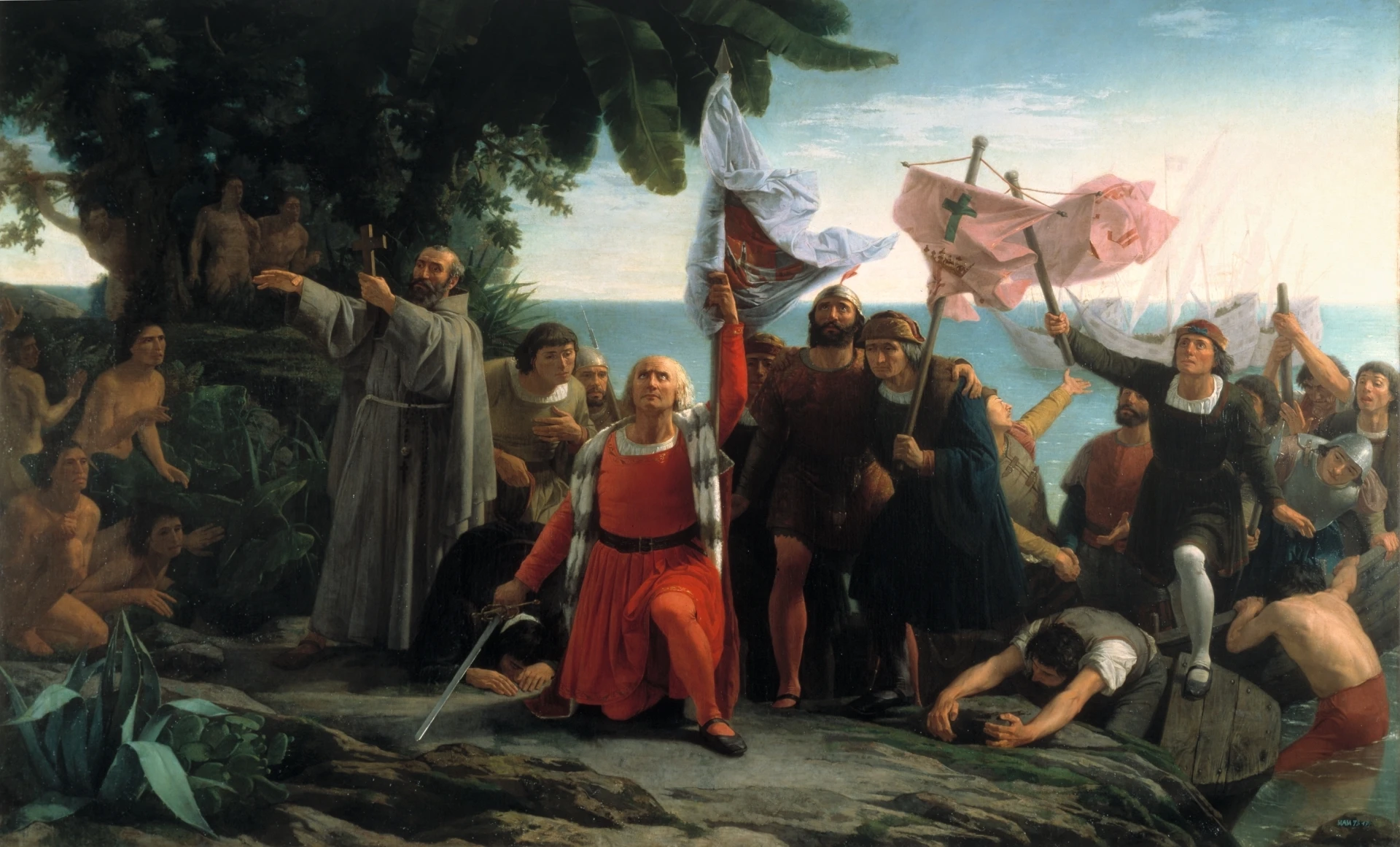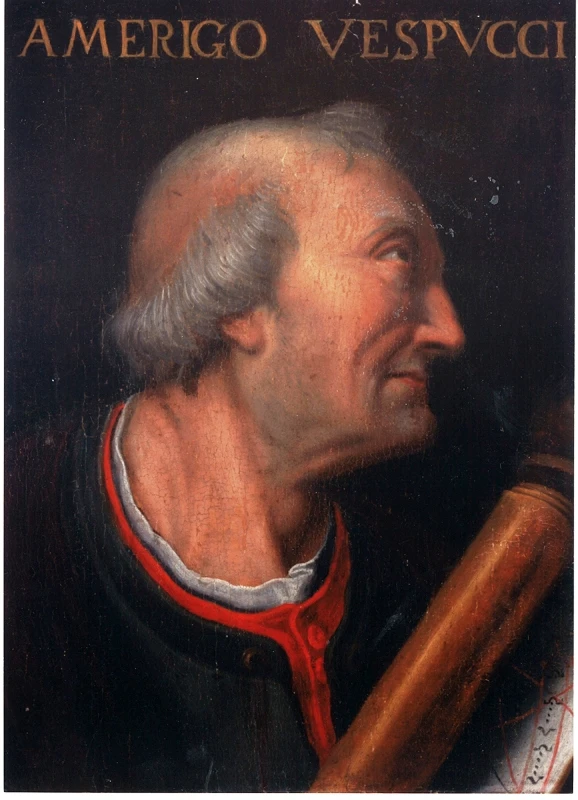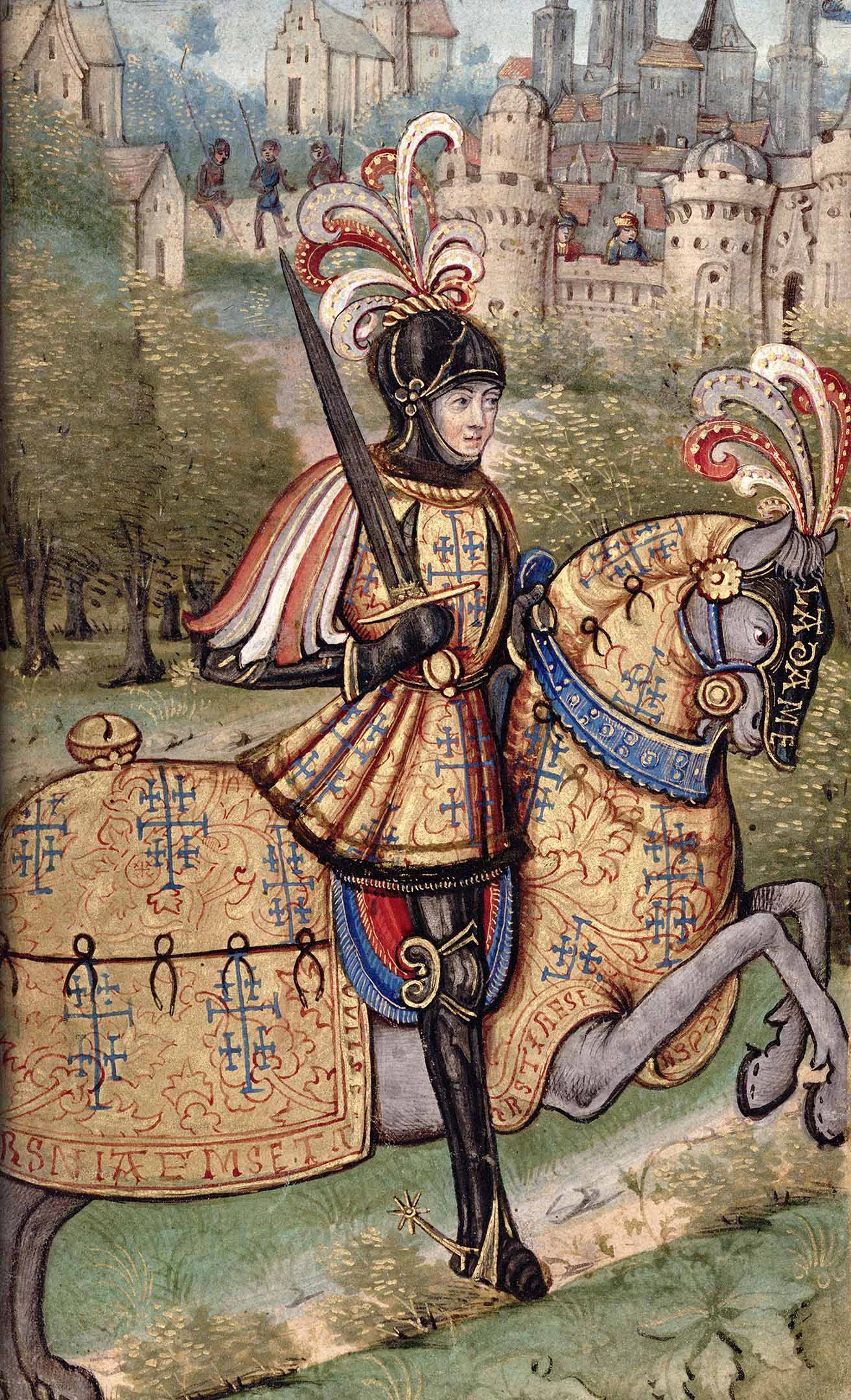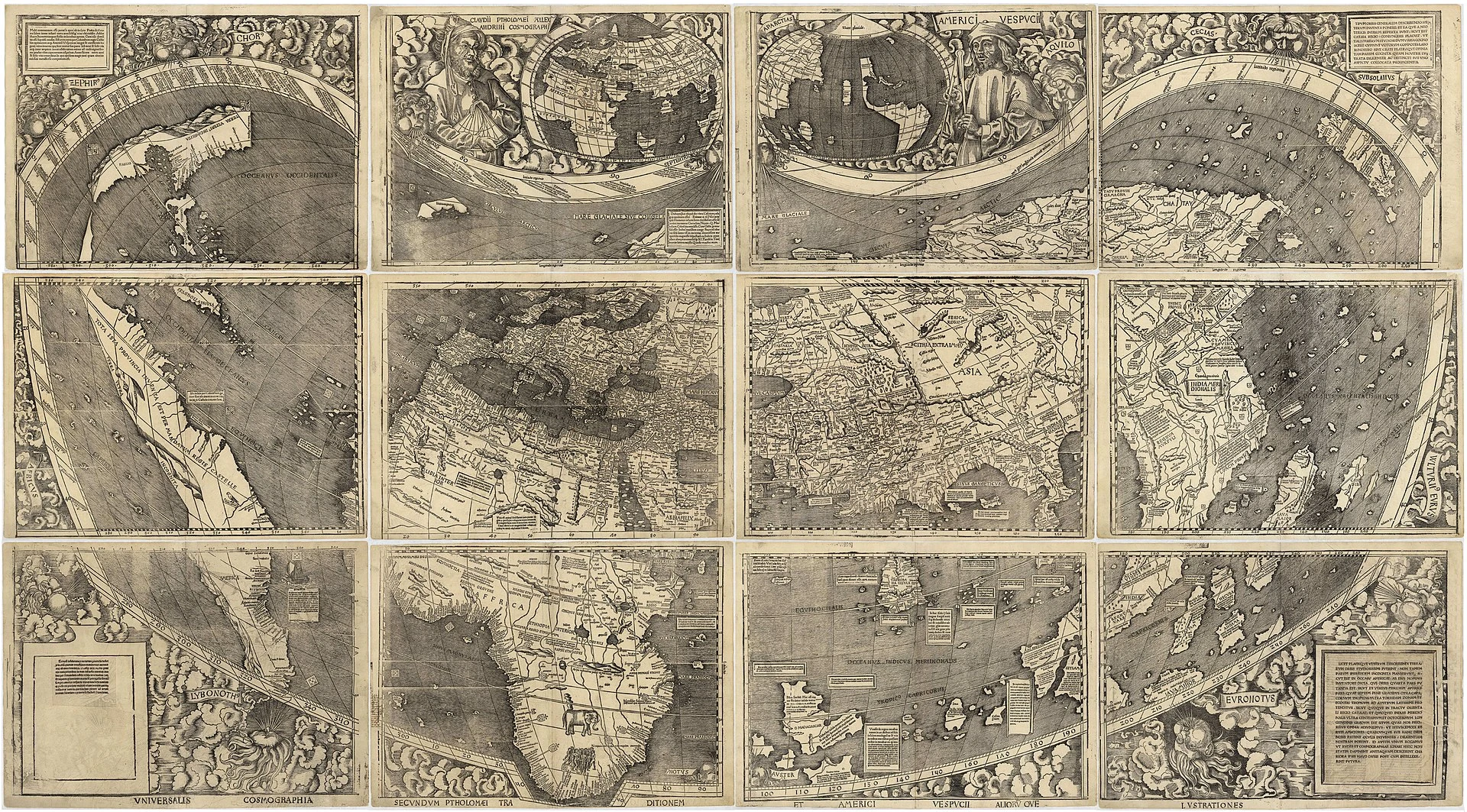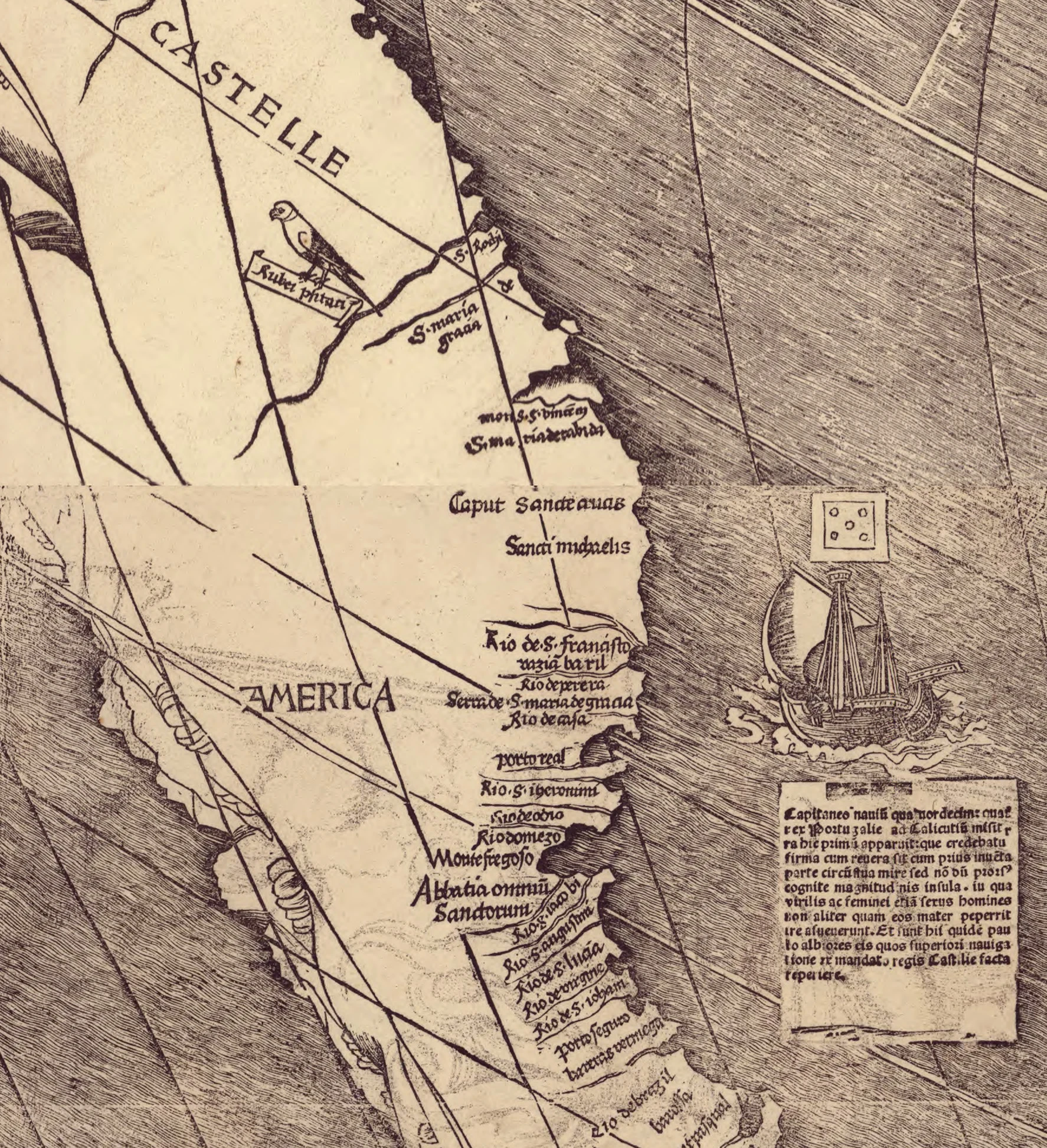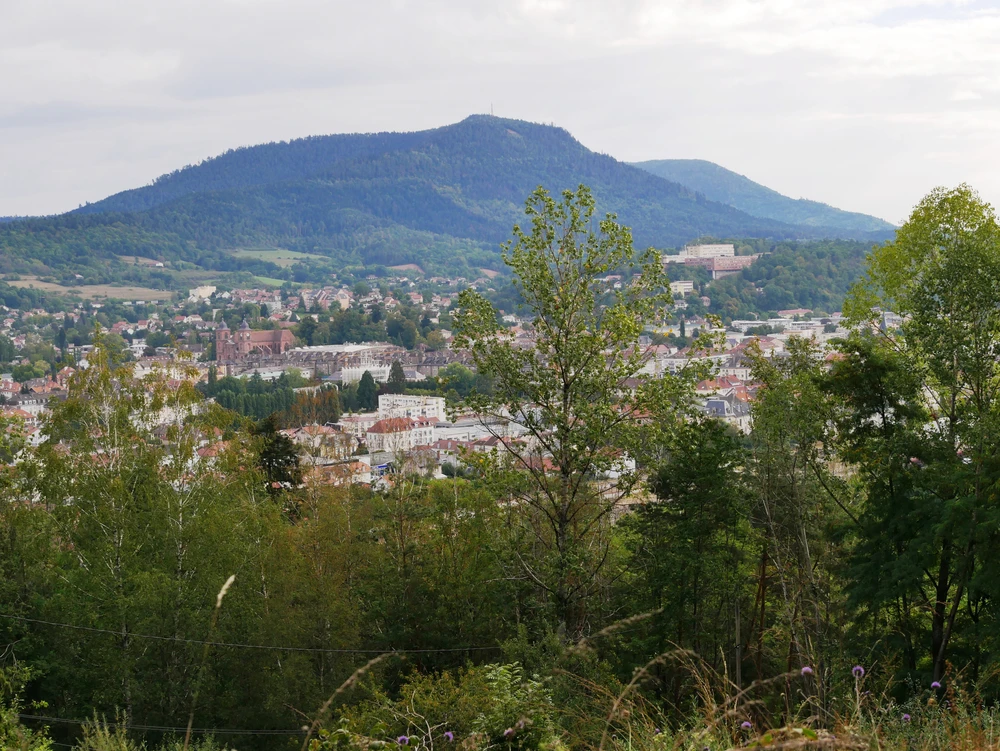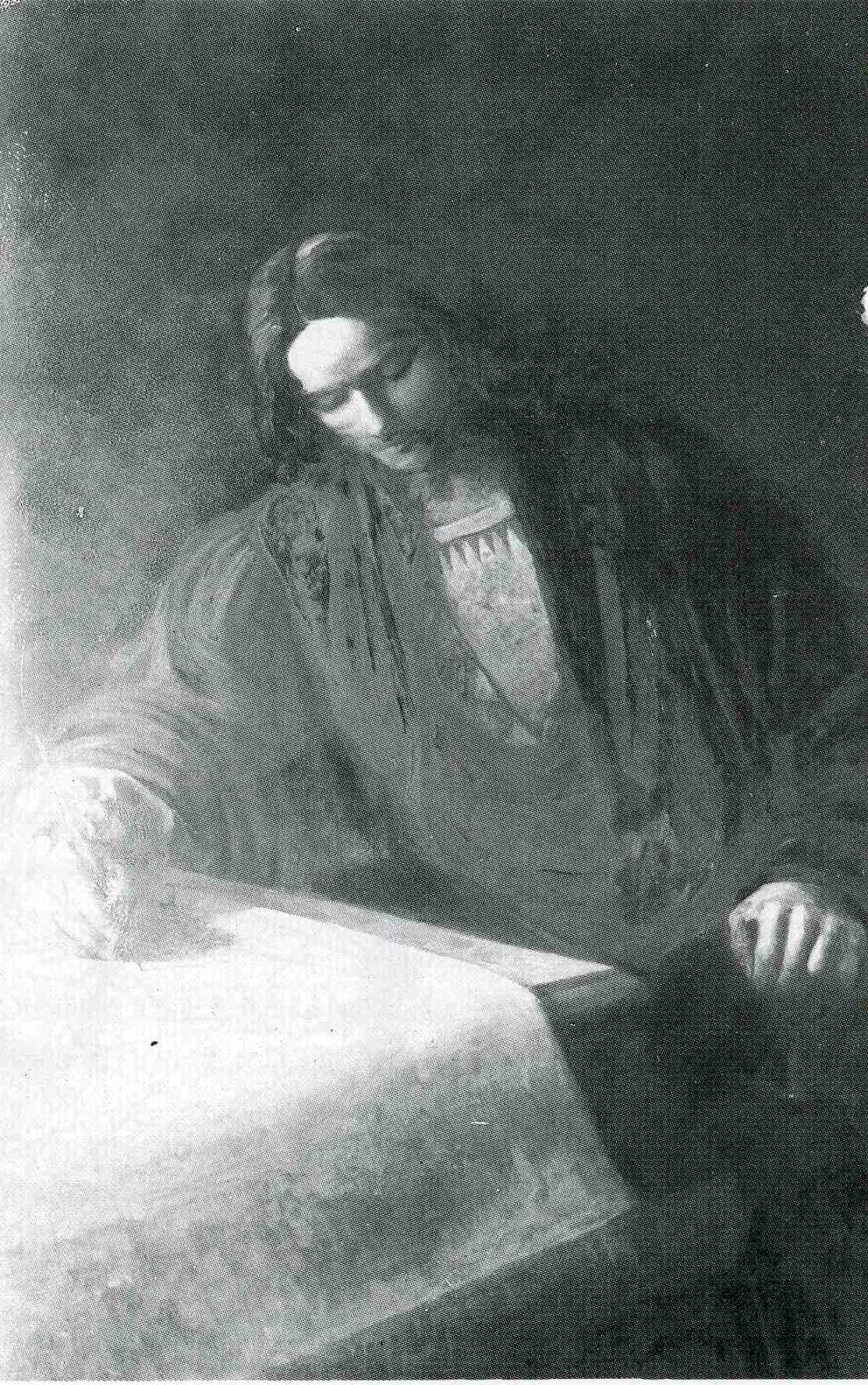A new road to India?
On October 12, 1492, three Spanish ships, "la Pinta", "la Nina" and "la Santa Maria" approached what is today the island of Guanahani in the Bahamas archipelago. A little later, Christopher Columbus landed with a handful of men and named the island "San Salvador" since it is the day of the "Holy Savior" in the Catholic calendar in use in Spain.
La découverte de l'Amérique par Christophe Colomb. Illustration chosen by monsieurdefrance.com : Dióscoro Teófilo de la Puebla Tolín - Collection, Museo del Prado / Madrid.
Columbus and his sailors discover the first "Indians", so named by Christopher Columbus because he's convinced he's in India and has succeeded in the gamble that convinced the Queen Isabella of Castile to finance his expedition: find a new route to the Indies and their treasures, without passing through Africa, by going straight west from Spain since the earth is round. What he hadn't imagined was that, even though the earth is round, it's bigger than he'd imagined, and between Spain and Asia lies an entire continent. Columbus would never know this. He died in 1506 without realizing that he had just discovered America.
Christopher Columbus died convinced he had reached India, unaware that he had discovered a new continent.
Amerigo Vespucci's letters
Post-life portrait of Amerigo Vespucci. Italy / Florence / oil on canvas.
A few years after Christopher Columbus's voyage, a Florentine named Amerigo Vespucci (1454 - 1512) took part in a number of expeditions to the West in the footsteps of Columbus, and even a little further afield, to the coasts of Brazil - although some historians now claim he didn't take part, but would have noted down what was brought back - and he brought back a whole series of observations, essays on maps.... And his writings began to make the rounds of scholars of the day, well helped by the invention of printing a few years earlier. Most of his writings are collected in a work called "Mundus Nuvus". And this work reached Lorraine a few years later...
Vespucci's letters, distributed in Europe thanks to the printing press, popularized the idea of a "New World".
In Lorraine: a duke and scholars
At the time, it was the Duke René II de Lorraine et de Bar who reigned over this independent duchy bordering the kingdom of France. Passionate about knowledge, the duke, who resided in Nancy, liked to furnish his library, and it was quite natural that he was sent the letters in which Amerigo Vespucci explained what he had seen. This work, the Duc de Lorraine sends to the Gymnase Vosgien.
Le duc René II de Lorraine / Illustration chosen by Monsieur de France: wikicommons.
It was in Nancy, thanks to Duke René II, that Vespucci's letters reached Saint-Dié-des-Vosges.
Le Gymnase Vosgien
Don't go imagining sportsmen when we say "gymnasium", far from it! This Gymnase Vosgien is a kind of learned assembly that meets in Saint-Dié-des-Vosges, a town in the duchy of Lorraine. This assembly is made up of several scholars. It was equipped with very modern resources for the time, including a printing press. It was these scholars who, in 1507, would give America its name.
The Gymnase Vosgien, founded by Vautrin Lud, was a unique learned society with a modern printing facility.
Scientists discover a 4th continent
Passionate about knowledge, and intent on updating the geography of their time, the scholars of the Gymnase Vosgien are making a kind of grand compilation of everything known in 1507. They compile not only what they've just read from Amerigo Vespucci, but also what has always been known, notably the writings of Ptolemy. And they set out to draw a map of the world. And looking at this map, they deduce several things: first Christopher Columbus didn't discover a new route to the Indies and secondly, most importantly: everything brought back from the West by European explorers leads us to believe that it was indeed a new continent that was discovered in 1492. In fact, it had to be named...
In 1507, Vosges scholars concluded that Columbus had not found the Indies, but a new continent.
Waldseemüller's planisphere first drawn in Saint Dié des Vosges in 1507. The oldest version is in Washington D.C. The island on the lower left side is America. source : Wikipedia
And they call it "America".
In the West, continents have always been named after women and in Latin: Europa, Asia, Africa are the names of the three continents known in 1507 (which, incidentally, correspond to the three wise men who came to the Manger to greet the infant Jesus). The Vosges scholars therefore decided to name this continent after a woman. Rather than Christopher Columbus, who screwed up when he thought he'd discovered India from the west, they took their inspiration from the famous Amerigo Vespucci, who seems to agree with them that what lies to the west is much more than a few islands or even another facade of Asia. They pay tribute to the man whose writings enabled them to make their discovery, and are inspired by his first name: Amerigo is the Italian version of the Latin "Americus". And here they are, inscribing the name "America" on the map. This map is Waldseemüller's planisphere, which will be printed many times. The earliest version is in the Library of Congress of the United States of America, Washington D.C.
The name "America" first appears on Waldseemüller's map of Saint-Dié-des-Vosges in 1507.
Detail of the planisphere: the word America is drawn on what appears to be a large island. It would be more than 2 centuries before the discovery of the 5th continent. source: Wikicommons
Saint-Dié-des-Vosges, America's godmother
The town of Saint-Dié-des-Vosges still exists, of course. It's located in the department of Vosges, in the middle of the mountains, on the banks of a river called the Meurthe. It has around 20,000 inhabitants. No one has forgotten that it was here that America was given its name. Shortly before the First World War, an American ambassador hailed the city as "America's godmother", a nickname that has stuck. Indeed, it was the United States that financed much of its reconstruction after its near-complete destruction by the Nazis in 1944. It is also Capital of the World of Geography and the scene of the Festival International de Géographie, once a year in October, which brings together geography scholars and helps to spread geography to the general public.
Saint-Dié-des-Vosges retains its title of "Godmother of America" and hosts the International Geography Festival.
The town of Saint Dié des Vosges today. Photo chosen by Monsieurdefrance.com : LACROIX CHRISTINE / Shutterstock.com
FAQ: How did America get its name?
Why is America called that?
Because the scholars of Saint-Dié-des-Vosges, in 1507, chose to honor Amerigo Vespucci by feminizing his first name to "America".
Why not call it Colombia?
Christopher Columbus believed he had discovered Asia and never realized it was a new continent. Scholars preferred the more far-sighted Vespucci.
Where can I find Waldseemüller's original map?
The oldest preserved version is at the Library of Congress in Washington D.C..
Why is Saint-Dié called America's godmother?
Because it was in this city that the name "America" was first given to the new continent.
The German cartographer Martin Waldseemüller (portrait painted by Gaston Save to decorate the former theater in Saint-Dié-des-Vosges, now defunct) / Illustration chosen by Monsieur de France: By Gaston Save - Catalogue of the exhibition "America, L'Amérique est née à Saint-Dié-des Vosges en 1507" (1992), Domaine public, https://commons.wikimedia.org/w/index.php?curid=800489
Practical information
Saint Dié des Vosges is located in the Vosges department, in the historic region of Lorraine, in the administrative region of Grand Est;
By road and rail:
The town is about 4 hours from Paris, 2 hours from Luxembourg and 1 hour from Strasbourg;
It has a train station, including a TGV stop;
Les sites web :
Saint Dié des Vosges Tourist Office
Tourism in the Vosges department;
Sorry for the language mistakes. Our translator is a bit like the Christopher Columbus of foreign languages: he thinks he has found a language and he has discovered something else...

